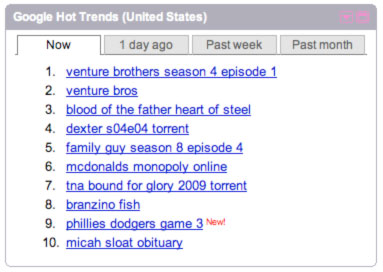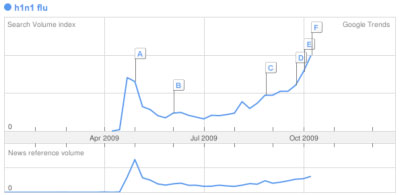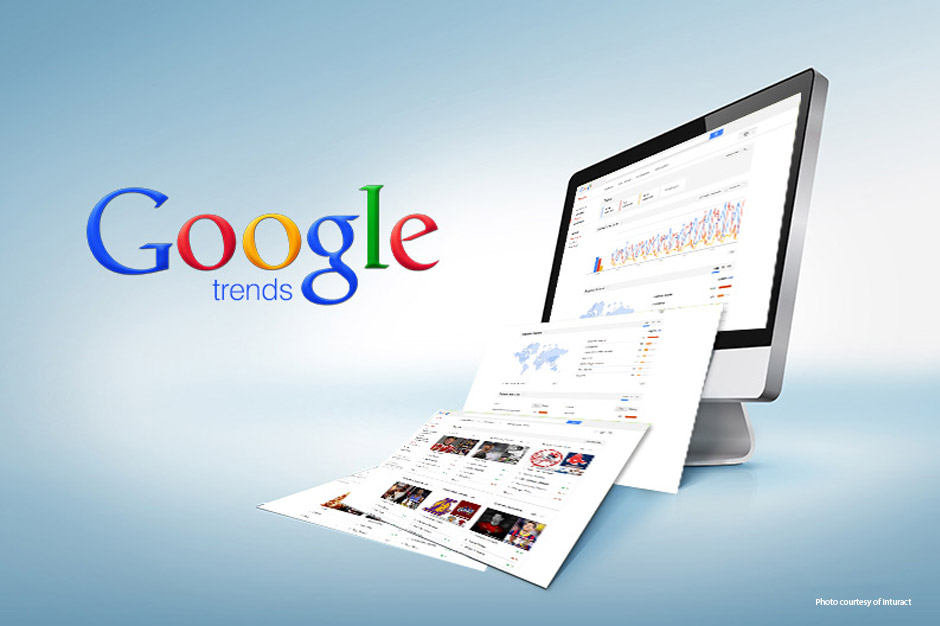Many of you may have recently asked me about some of the widgets and apps that track the hottest searches on the web over the past hour or day. These little snapshots of web activity are beyond interesting - they give us a tremendous glimpse at the psychology of the U.S. consumer (see Google Hot Trends from iGoogle below).

While following these Google "hot trends" over the past year, one thing has become very obvious to me: we are a nation consumed by the stars and entertainment. 75% of all top searches involved a Hollywood, sports, or reality TV star or episode/game and their related fortune (or more often, misfortune).
But in that other nugget (25%) we find some amazing insight as to how consumers learn about, search, and then buy products and services. These sources primarily break down into three categories:
News - natural disasters, world events, epidemics, recalls, and more. News is by far the leading source of both the "star" search mentioned above and this secondary category where products and services are sold.
Take the swine flu (H1N1) - one of our clients that produces a product that kills germs is two months behind in manufacturing enough product to meet demand. When tracking "swine flu" and "H1N1," these 2 terms appear in the top 10 hot trends on a fairly regular basis.
In the image below, the term "H1N1 Flu" wasn't even searched until April 2009. As its infection rate decreased over the summer, so too did its search level. Now that it is again active, the search trend is increasing each day. Each of the letters in the graph relates to the news item. The top line shows the search activity and the bottom line shows the news activity. The letters on the top line pinpoint key major news stories. The correlation is indisputable.

Another client saw its sales increase 10% overnight due to the pet food contamination two years ago. Fortunately, they were one of the few pet foods that doesn't include the suspect ingredient in their manufacturing process.
The point is clear: it's important to prepare our communications to deploy at a moment's notice. There are few opportunities available where news items that awake the national/international pysche directly relate to a product or service we sell. And when that conscience is raised, the opportunity to sell may be very short-lived.
Advertising Media - DRTV, radio, newspaper, billboard, product placement, etc. It follows reason that this would be another source of Google hot searches. But don't be certain that buying airtime is the panacea for getting attention in search. For all the advertising media that most major corporations buy, they rarely find themselves anywhere near the top of Google hot trends.
Those products or services that break through are usually new (e.g., Snuggie blanket, iPhone) or related to a promotion (e.g., McDonald's Monopoly [see in image 1 above], Oprah's car giveaway).
What's very important to note about advertising media is that the attention gained does not always equate to sales. Search is usually the intermediary step and if something, anything, interrupts the buying cycle, the prospect is lost. Our web assets and/or buying vehicle have to be razor-sharp in position and short in distance to sale.
Public Relations - online, broadcast, news. There's a very fine line between "news" and public relations. News happens organically and public relations happens intentionally. However, the buying public is hard-pressed to notice the difference.
When public relations is deployed well, there's little that can stop it. The beauty of public relations is that search can be anticipated based on the keywords seeded within the PR effort. Building online assets to receive the increased traffic can be done in a very focused way, ensuring the PR "drives" the user to its intended spot.
The same can't be said of the category of news mentioned above, simply because a company is unlikely to affect the news angle even if the event was anticipated. Additionally, your competition is just as likely to benefit from the news since there's much less that can be done to shape the message.
There are rich insights Innis Maggiore has gained into the search-and-buy psychology. One thing that stands above all of them is that while it's impossible to predict the future, it's certainly dangerous to ignore it. With the many analytics tools available today, monitoring - real time - the current trends not only gives us a peek at the buyer conscience but also how our own communications efforts are working.
Avoid the marketing-by-reaction syndrome. Instead, append your ongoing marketing efforts with a communications toolkit that can be deployed at a moment's notice.



